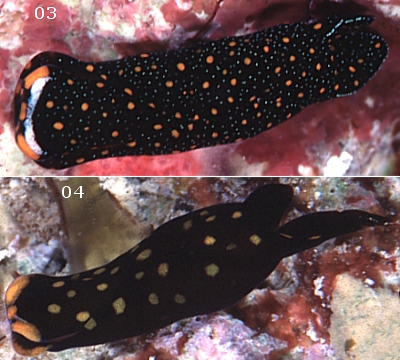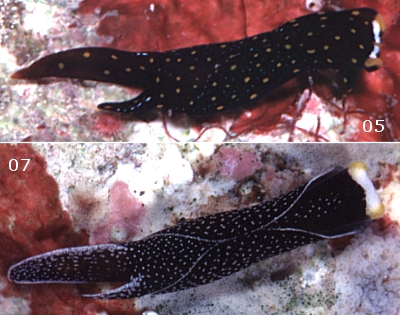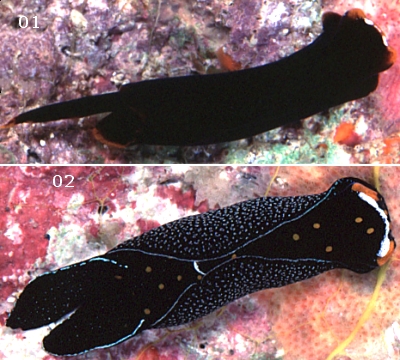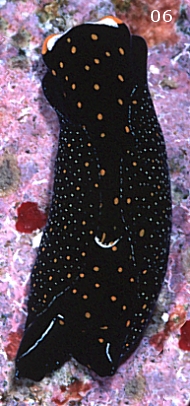

Chelidonura sp. 6
yellow-spotted species from Japan
Order: CEPHALASPIDEA
Superfamily: PHILINOIDEA
Family: Aglajidae
PHOTO
Kerama Is, Okinawa, Japan. Photos: Atsushi Ono
See discussion below about whether these are one or more species.
Authorship detailsRudman, W.B., 2003 (June 5) Chelidonura sp. 6 yellow-spotted species from Japan. [In] Sea Slug Forum. Australian Museum, Sydney. Available from http://www.seaslugforum.net/find/chelsp6
Related messages
About yellow -spotted Chelidonura in Japan
June 7, 2003
From: Atsushi Ono

Dear Bill,
Following the discussion on Chelidonura inornata and C. flavolobata, I think Chelidonura inornata is a very variable species.
I think the attached are all C. inornata.
001 has no spots on body and parapodia, and tips of tails are red in color.
002 has orange spots on body, and white dots on parapodia.
003 has many orange spots and white dots on a body and parapodia.
004 has faint white band across the head, and has big orange spots on body and parapodia.
005 has many white dots on parapodia but has a few white dots on a body.
006 has many white dots on parapodia and has no white dots on a body.
007 has only white dots on a body and parapodia.
All are from Kerama Is., Okinawa, Japan.
Sincerely,
Atsushi Ono
ononini@cosmos.ne.jp



Dear Atsushi,
Thanks for these interesting photos. I had wondered about some of these animals which were in your Kerama Island book. Firstly, C. inornata throughout the Pacific only has white specks on the parapodia and sole of the foot, the head shield and posterior shield being pure black. I guess its possible that for some reason the northern Pacific population has become more variable in colour but since 'typical' specimens were first described from Japan this seems unlikely.
A second question is whether your 7 photos are all the same species? If we forget the colour pattern for a moment and look at their shape we see that some have a pair of very short posterior mantle processes ('tails')[2,3,6]; two have a pointed left tail and a short rounded right tail [4,1]; one has a long and short pointed tail [5]; and one has a long pointed left tail and a short rounded right tail [7]. I am not sure what all this means, but if they are all the same species then we will need to rethink the importance of 'tail shape' in the genus.
The other thing we need to consider is the other yellow spotted species that have been described from Japan, in particular Chelidonura fulvipunctata and C. tsurugensis. C. fulvipunctata seems to be easily distinguishable by its W-shape marking on the head, but I am still unsure of the identity of C. tsurugensis. The only photo which seems to match is Bob Bolland's photo from Okinawa. From Baba & Abe's original description the animal is black with yellow orange spots on the dorsal surfaces, and a white patch on each side of the midline at the front of the head. The left 'tail' is long and pointed and the right tail short and rounded. I have wondered whether the widespread Chelidonura sandrana was a synonym but until we understand the yellow-spotted species from the Japanese region better it is hard to be sure.
So basically, I doubt whether any of these are C. inornata but then I could be quite wrong. If they are not C. inornata I really can't say what they are, or even whether they are all the same species.
Best wishes
Bill Rudman
